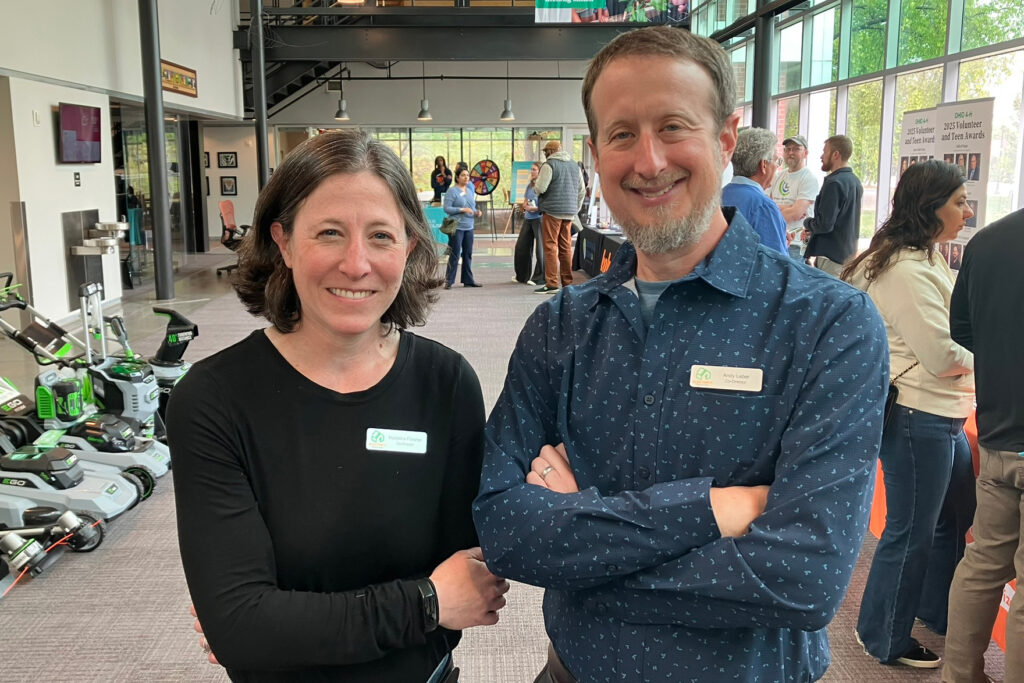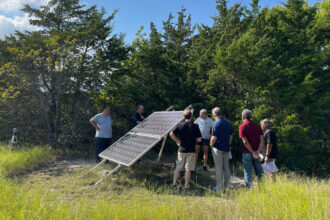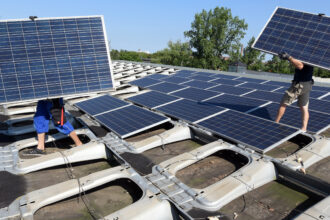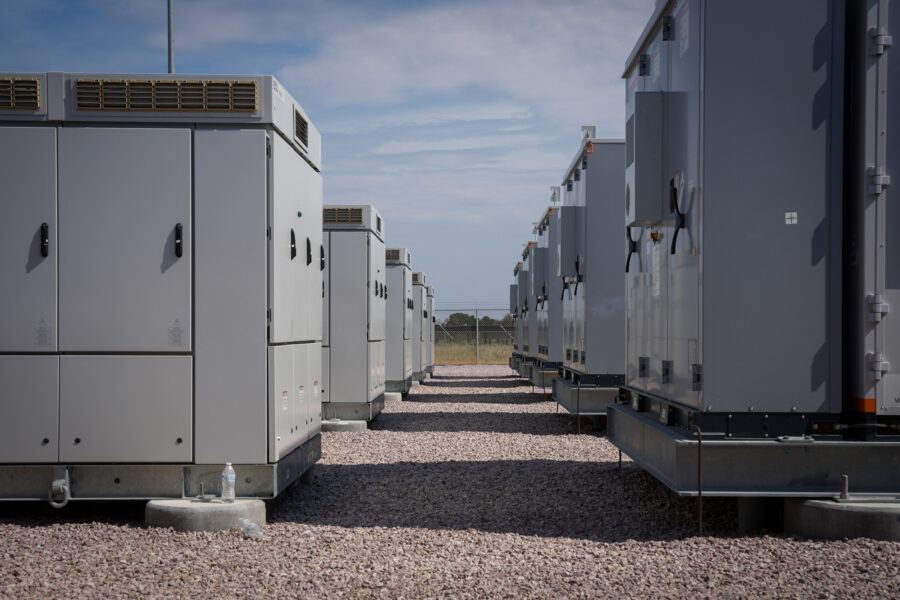There is a long-running debate over the relative weights of individual and government responsibility in limiting the effects of climate change.
Now, at a time when the U.S. government is largely abdicating its role, I spent a Saturday hanging out with a group that focuses on what its members can do in their households and community.
It was an antidote to cynicism.
The event was the Energy Smart Home Expo, organized by Electrify Central Ohio and held at Ohio State University, a few miles from where I live in Columbus. The exhibitors included rooftop solar companies, electric vehicle advocates, energy efficiency professionals and environmental nonprofits, among others.
One of my first stops was a table where volunteer Rachel Kutzley demonstrated gadgets that could help people reduce their utility bills.
She pointed a thermal camera at a mug of hot tea and the camera’s screen showed heat leakage from the top. At home, I could use this to identify the areas around windows, baseboards and other parts of the house where heat is leaking. Once I have this information, I can fill those gaps with caulk or other materials.
“That can be the best way to bring down your home heating costs,” she said.
A thermal camera costs about $150, or, if you have a group like Electrify Central Ohio in your area, you can easily borrow one for a day.
She also had a smart plug, which is a device you can insert in a wall outlet and then you plug your appliance or home electronic device into it. The plug, which you can buy for as little as $10, will tell you how much electricity the device is using, and it can help you identify energy hogs in the home that can be unplugged when not in use.
I asked her a version of the question I asked almost everyone that day: How do you muster enthusiasm for saving energy at a time when the federal government has largely abandoned its ambitions to make a shift to cleaner power?
“We need to do the right thing for the next generation,” she said.
I wanted to get an advocate’s perspective, and found one just a few tables down. Mryia Williams is the senior Ohio program assistant for Solar United Neighbors, a nonprofit that organizes group-buying programs for rooftop solar and advocates for solar-friendly policies.
In her spare time, she serves as the volunteer executive director of Drive Electric Columbus, a group that promotes EVs.
Williams’ two advocacy passions took big hits from the Trump administration’s One Big Beautiful Bill Act, which had rapid phaseouts of tax credits for solar and EVs. Ohio’s state government isn’t much better, having mostly abandoned policies that sought to encourage renewable energy.
So how does she keep going?
“I’m going to get up every day, I’m going to go about helping people, just like I’ve always helped them,” she said.
Part of what motivates her is the belief that rooftop solar and EVs are doing good in the world, and that good has value even in small doses.
Across the aisle from her was Appalachian Renewable Power, a solar installer based in Athens, in southeastern Ohio. John McNamara, the company’s chief operating officer, said the phaseout of federal tax credits is a blow, but his company still anticipates a strong 2026.
A key factor, he explained, is that the payback period—the time it takes for electricity bill savings to cover the costs of buying rooftop solar—is still pretty good even without tax credits. This period is about four years right now, with tax credits, and it would be about six years without tax credits.
And, utility rates continue to rise, which means additional savings for consumers who produce their own electricity, he said.
Electrify Central Ohio is run by two volunteers, Madeline Fleisher, an attorney specializing in energy issues, and Andy Leber, an Ohio State psychology professor. They formed the group in 2022 after each of them had completed projects in their homes to reduce the fossil fuel use, and they realized there wasn’t an easy way for local residents to find answers to basic questions.

They formed a Facebook group and host online and in-person meetings where the public can share contractor recommendations, talk about experiences with equipment such as heat pumps and generally commiserate.
I asked Fleisher if the organization has changed its focus now that the federal government has pared back much of its support for reducing emissions.
“What we were doing has not changed at all,” she said. “It has always been about helping people understand what their options are in the world today.”
Any substantial change will eventually require government buy-in, Fleisher said, but there remains a role for individuals to make progress in the meantime. She noted that about one-third of Ohio’s carbon emissions come from residential energy use and driving private vehicles. She wanted to drive home the point that people can do a lot to reduce emissions in their own lives, even in the absence of government action.
This story is funded by readers like you.
Our nonprofit newsroom provides award-winning climate coverage free of charge and advertising. We rely on donations from readers like you to keep going. Please donate now to support our work.
Donate NowLeber said it’s a false choice to talk about whether progress comes through structural changes by government or through consumer choices of consumers. Both are crucial in the fight against climate change.
“The answer is that the government and individuals need to do everything they can,” he said.
But he is also mindful of a trope of climate denial in which governments and companies blame rising emissions on consumers to shift responsibility away from themselves. It’s possible to reject this form of climate denial while still realizing that individual actions can do a lot of good, he said.
I’m going to end with a treat. Among the businesses with a table was The Buckeye Lady, which specializes in making buckeye candy, a chocolate and peanut butter confection that looks like the nut from the buckeye tree.
Alicia Hindman, the Buckeye lady herself, who now has a storefront and a regional following, was at the expo to demonstrate the virtues of a portable induction cooktop. An induction cooktop runs on electricity, using a magnetic field to heat the cookware and its contents, while the cooktop surface remains cool.
She stirred melted chocolate on the cooktop and explained why this was preferable to cooking with gas.
“They conserve energy, which is really nice, and they conserve space, so you don’t have to house a whole stove,” she said.
This was a recurring theme at many of the tables, and it offers hope for broader consumer adoption: Cleaner technologies often have advantages in terms of quality and lifetime costs, to the point that the environmental benefits become an afterthought.
Other stories about the energy transition to take note of this week:
The Trump Administration Shifts the Offshore Wind Industry Into Reverse: President Donald Trump has used the levers of government to slow and even stop development of offshore wind power, as Andrew S. Lewis reports for Mother Jones. This story is a good roundup of months of actions that have combined to cause damage to the nascent industry, raising concerns about states’ ability to reduce their fossil fuel use.
Elon Musk’s Politics May Have Cost Tesla 1 Million Vehicle Sales: Yale University economists have issued a working paper in which they find Tesla’s U.S. sales would have been between 67 percent and 83 percent higher from October 2022 to April 2025 if not for the effect of CEO Elon Musk’s partisanship, which drove customers away Musk’s support for Donald Trump has cost Tesla sales with environmentally minded customers who were likely to oppose Trump’s politics, as Akash Sriram reports for Reuters.
The Trump Administration Seeks to Speed Data Center Grid Connections: The Department of Energy has proposed a rule that would expand federal control over how large electricity users connect to the grid, accelerating the building of data centers and power plants that serve them, as I wrote for ICN. Among the interesting parts of the proposal is a 60-day timeline to approve grid connections for projects, if the developer is willing to make the data center flexible about the amount of power it needs at any given time. Companies are going to want this expedited approval, which means we are likely to see more projects like the one Aligned Data Centers is planning for an undisclosed location in the Pacific Northwest, pairing a data center with a 31-megawatt battery, as Julian Spector reports for Canary Media.
Is It Possible for U.S. Solar Installers to Reduce Costs to $2 Per Watt? One of the big challenges for rooftop solar adoption in the United States is the inability to drive down costs even as panel prices decrease, as Lisa Martine Jenkins writes for Latitude Media. The cost of a rooftop system here is about $3 per wall, while it’s $1 per watt in Australia. A recent report from Tesla says lower prices are possible through a combination of regulatory changes, improvements in how installers operate and cost-saving innovations in the design of some parts. A separate report from the nonprofit Permit Power found that if installers can get costs down to $1 per watt, it would lead to 18.2 million more families installing solar and add about 200 gigawatts of additional capacity.
Inside Clean Energy is ICN’s weekly bulletin of news and analysis about the energy transition. Send news tips and questions to [email protected].
About This Story
Perhaps you noticed: This story, like all the news we publish, is free to read. That’s because Inside Climate News is a 501c3 nonprofit organization. We do not charge a subscription fee, lock our news behind a paywall, or clutter our website with ads. We make our news on climate and the environment freely available to you and anyone who wants it.
That’s not all. We also share our news for free with scores of other media organizations around the country. Many of them can’t afford to do environmental journalism of their own. We’ve built bureaus from coast to coast to report local stories, collaborate with local newsrooms and co-publish articles so that this vital work is shared as widely as possible.
Two of us launched ICN in 2007. Six years later we earned a Pulitzer Prize for National Reporting, and now we run the oldest and largest dedicated climate newsroom in the nation. We tell the story in all its complexity. We hold polluters accountable. We expose environmental injustice. We debunk misinformation. We scrutinize solutions and inspire action.
Donations from readers like you fund every aspect of what we do. If you don’t already, will you support our ongoing work, our reporting on the biggest crisis facing our planet, and help us reach even more readers in more places?
Please take a moment to make a tax-deductible donation. Every one of them makes a difference.
Thank you,













